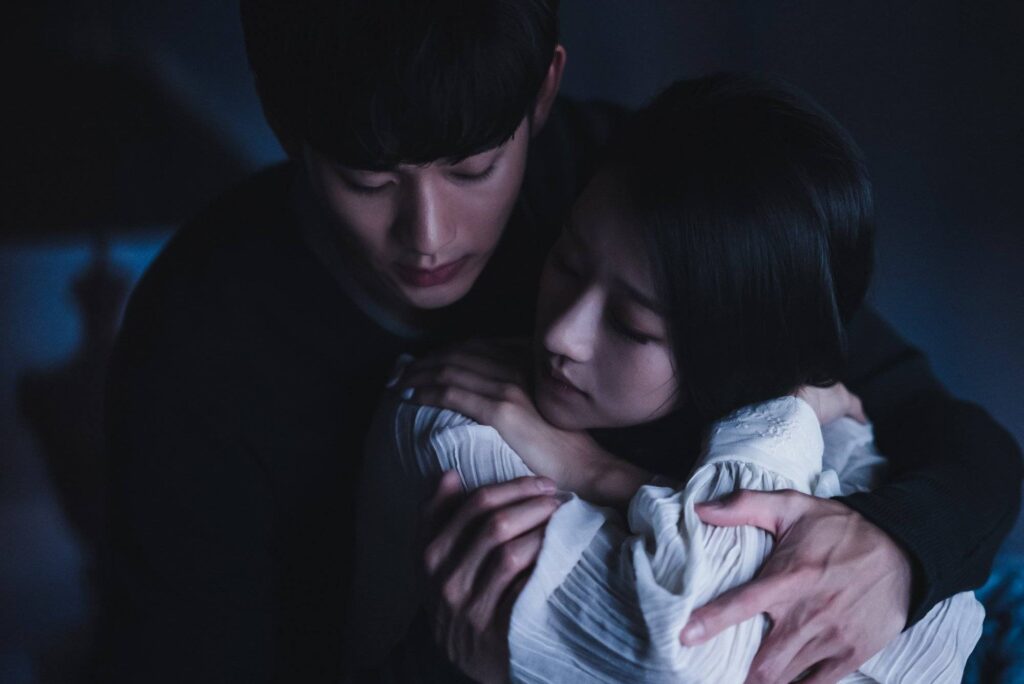
Kim Soo-hyun (back) and Seo Yea-ji (front) in a still from ‘It’s Okay Not to Be Okay.’ Photo: courtesy of TVN.
When I think of a K-drama that tackles mental health and healing with a rare kind of maturity and sensitivity, the first name that comes to mind is It’s Okay to Not Be Okay (2020). The show holds a magnifying lens to life’s messier complexities, exploring trauma, emotional vulnerability, and stigma around mental health with nuance. And in doing so, it reinforces a powerful message: it’s perfectly fine even when you’re not okay.
The drama fosters a deeper understanding of the human experience by grounding itself in layered but flawed characters, each carrying invisible burdens. Ko Mun-young (Seo Yea-ji), a reclusive but popular children’s book writer, shows signs of antisocial personality disorder due to a traumatic past. Her life becomes entangled with the kind and compassionate Moon Gang-tae (Kim Soo-hyun), a psychiatric unit attendant devoted to caring for his brother Moon Sang-tae (Oh Jung-se), who is on the autism spectrum.
While Gang-tae has long been a shoulder to lean on, he’s also quietly carrying his own weight—looking after his brother, who’s still grappling with the tragic loss of their mother. But his demanding life is suddenly upended when Mun-young enters the scene. Smitten with him, she follows him to Seokjin City, where he starts working as a caregiver. As the plot intensifies, the three move in together, embarking on a shared journey of healing, all while slowly uncovering long-buried secrets and becoming the family they had each been longing for.
For Mun-young, this newfound family gives her all the comfort and connection she’d always craved, showing just how love and support can uplift mental well-being. At the same time, the show doesn’t shy away from talking about the importance of therapy. The techniques she learns, like the “butterfly hug” that Gang-tae teaches her to manage emotional triggers, underscore how valuable professional help can be in the process of self-healing.
Throughout the show, Mun-young’s flashbacks reveal her tragic past, while Sang-tae’s emotional outbursts and Gang-tae’s vulnerability expose how their mental health affects every aspect of their lives. But the K-drama approaches these problems with empathy rather than judgment. For instance, Sang-tae is depicted as a well-rounded character with depth rather than being reduced to his autism. He’s not just a passive character but someone who drives the plot forward and influences those around him. His interactions with others not only reveal their true characters but also encourage growth, such as when he gently feeds a distraught Mun-young porridge, carefully placing the egg on the spoon in a gesture that shows his increasing sensitivity. One of the show’s biggest strengths is its ability to focus on its characters’ personal experiences and relationships. This includes Gang-tae’s unwavering dedication to his brother, often at the expense of his own needs, as well as Sang-tae’s unconditional love for him, despite the challenges he faces.
Director Park Shin-woo uses symbols in interesting ways to tie together the characters’ predicaments and inner conflicts. Mun-young’s books, for example, are an insight into her troubled state of mind and the pain she continues to endure. Her stories, including The Boy Who Fed Nightmares and Zombie Kid, directly refer to her own nightmares and the eerie feeling that keeps nagging at her. The presence of butterflies in the episodes—literally and symbolically—represents change and renewal in life, while the camper van Mun-young and Gang-tae take on their trip symbolizes the journey toward healing and their evolving relationship.
Long story short, there’s a lot to learn from It’s Okay Not to Be Okay. It’s a drama filled with extraordinary performances, a gripping storyline, and meaningful takeaways. It’s no wonder that this series became one of Netflix’s best K-dramas in 2020. It reminds us that nobody’s perfect, and that’s okay—what matters is accepting yourself just as you are. Even in a frigid world, the warmth of loved ones can make all the difference. It’s okay to feel overwhelmed, to struggle, and even to ask for help. The story unfolds almost like a warm hug you didn’t know you needed.
Source:https://rollingstoneindia.com/k-drama-flashback-its-okay-to-not-be-okay/

